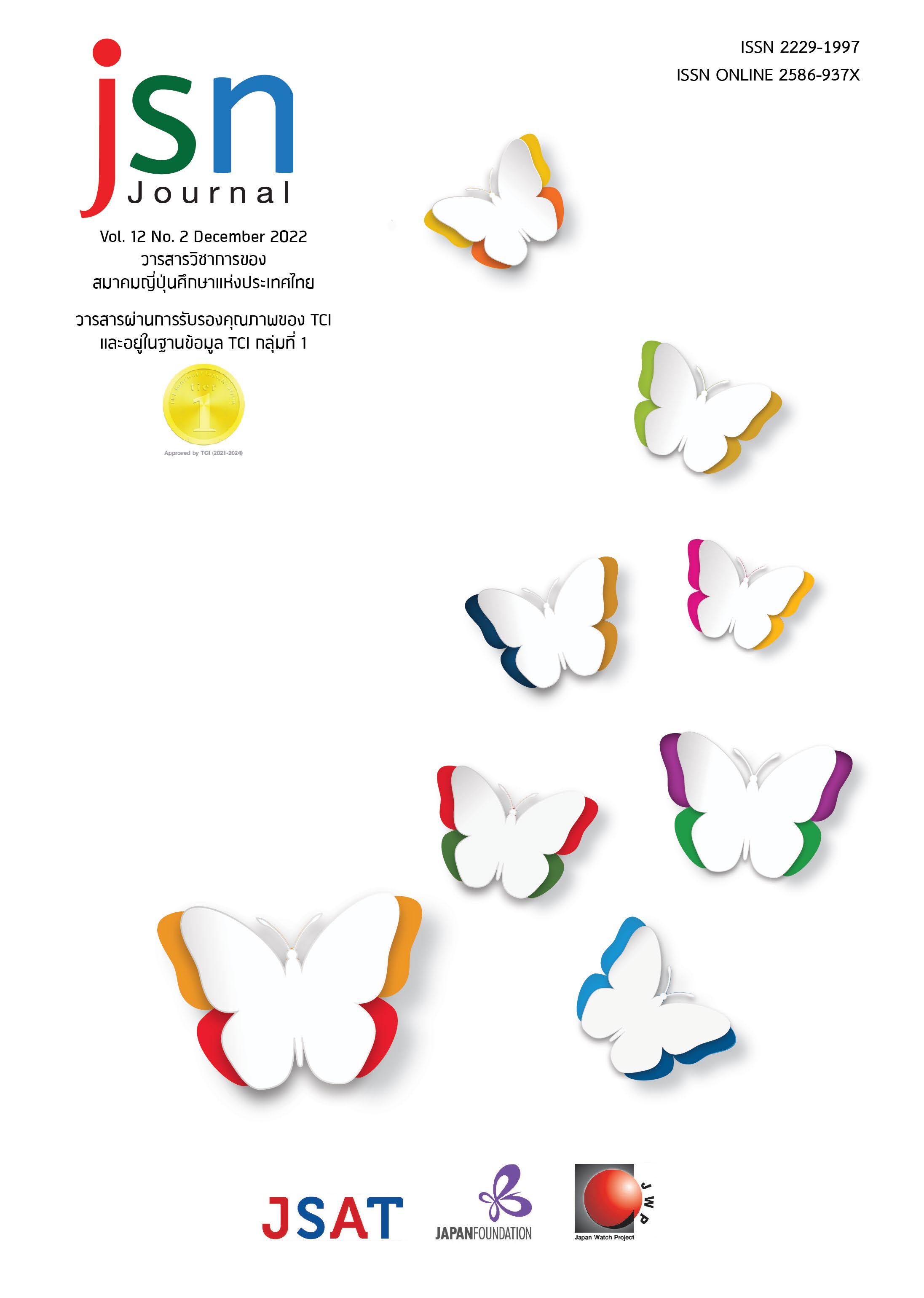A Corpus-based Study on the Use of Conjunctions in Thai Japanese Learners’ Essays
Main Article Content
Abstract
This research aims to study and compare the use of conjunctions in the essays of Thai Japanese learners and native Japanese. The data analyzed in this study was collected from the I-JAS corpus language archives. The study found that the use of conjunctions in essays by Thai learners is both similar and different to that of Japanese native speakers. Regardling similarities, Thai learners use the conjunction ‘shikashi’ ‘mata’ and ‘soshite’ as often as apanese native speakers. This may be because the data in this study are largely focused on the description of fast food and homemade food. Therefore, the participants use these conjuctions in order to form comparisons about the pros and cons, adding information, and explaining their reasoning. Regarding differences, Thai learners use more conjunctions like ‘soreni’ and ‘dakara’ in their essays compared to the essays of Japanese native speakers who use less conjunctions. This may be because native Japanese speakers understand the use of ‘soreni’ requires a connecting point between front-ended body text. For the conjunction ‘dakara’, it is primarily a spoken word. The native Japanese rarely use it in writing. Moreover, the research found that Thai Japanese learners overuse unnecessary conjuctions and they also omit necessary ones.
Article Details

This work is licensed under a Creative Commons Attribution-NonCommercial-NoDerivatives 4.0 International License.
ข้อความและข้อคิดเห็นต่างๆ ในบทความเป็นของผู้เขียนบทความนั้นๆ ไม่ใช่ความเห็นของกองบรรณาธิการหรือของวารสาร jsn Journal
References
กำชัย ทองหล่อ. (2537). หลักภาษาไทย. กรุงเทพฯ: รวมสาส์น.
ตาเกยิโร โทมีต้า, และปรียา อิงคาภิรมย์ โฮะริเอะ. (2540). ไวยากรณ์ภาษาญี่ปุ่น. กรุงเทพฯ: สำนักพิมพ์ดอกหญ้า.
พัชราพรรณ สุวรรณกูฏ. (2564). งานวิจัยเพื่อการสอนคำเชื่อม soshite สำหรับผู้เรียนภาษาญี่ปุ่นชาวไทย ศึกษาจากการใช้จริงในเรื่องเล่าบรรยายภาพและบทสนทนา. วิทยานิพนธ์ศิลปศาสตร์ดุษฎีบัณฑิต. มหาวิทยาลัยโอซากา.
สมเกียรติ เชวงกิจวณิช. (2547). การเชื่อมประโยคในเรียงความภาษาญี่ปุ่นของผู้ศึกษาภาษาญี่ปุ่นชาวไทย. วารสารศิลปศาสตร์, 4(1), 48-67.
อัษฎายุทธ ชูศรี. (2563). แปดประเด็นภาษาศาสตร์ภาษาญี่ปุ่นเบื้องต้น. กรุงเทพฯ: โครงการเผยแพร่ผลงานวิชาการ คณะอักษรศาสตร์ จุฬาลงกรณ์มหาวิทยาลัย.
A Corporation (2560). มินนะ โนะ นิฮงโกะ 1 [2nd Edition]. กรุงเทพฯ: สำนักพิมพ์ภาษาและวัฒนธรรม.
A Corporation (2560). มินนะ โนะ นิฮงโกะ 2 [2nd Edition]. กรุงเทพฯ: สำนักพิมพ์ภาษาและวัฒนธรรม.
石黒圭・阿保きみ枝・佐川祥予・中村紗弥子・劉洋 (2009).「接続表現のジャンル別出現頻度について」『一橋大学留学生センター紀要』12, 73-85.
市川孝. (1978). 『国語教育のための文章論概説』. 東京 : 教育出版.
落合哉人 (2019).「LINEテキストチャットにおける分析単位の規定と接続表現の使用傾向」『筑波日本学研究』23, 83-112.
徐衛 (2020).「日本語母語話者と学習者の学術論文における接続詞の調査」『花園大学文学部研究紀要』52, 19-25.
グループ・ジャマシイ. (2003). 『教師と学習者のための日本語文型辞典』. 東京 : くろしお出版.
日本語記述文法研究会編. (2009). 『現代日本語文法 7 第 12 部談話 第 13 部待遇表現』. 東京 : くろしお出版.
長谷川哲子 (2019).「経験を語る談話における接続詞使用:「そして」の使用について」 『Ex:エクス:言語文化論集』101-122.


